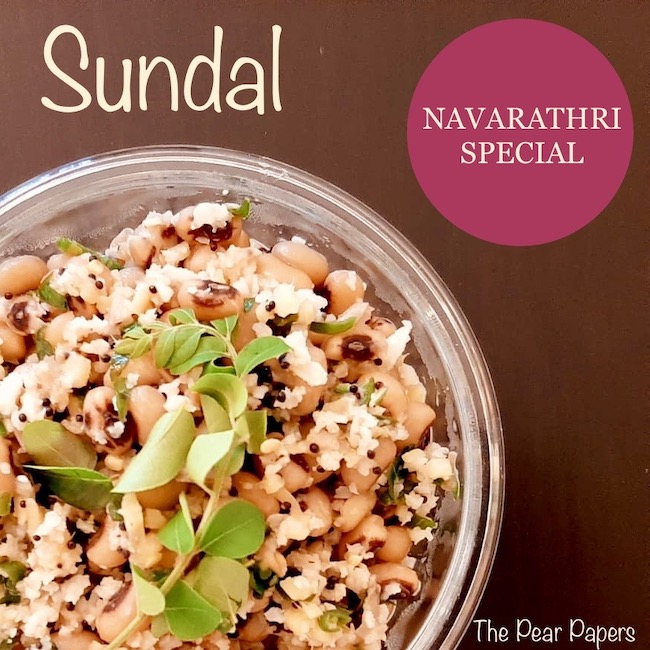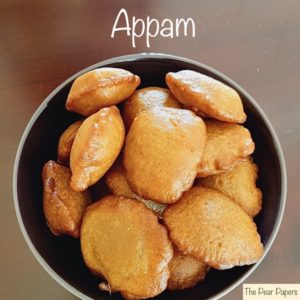
Sundal
Sundal is a traditional South Indian snack commonly made during the Hindu festival of Navarathri. ‘Nava’ means nine and ‘Rathri’ means night. Over a span of nine days and nights, the festival is celebrated to mark the victory of good over evil. Different parts of India have different ways of celebrating this festival. However one common thing that binds everyone is the great variety of food prepared during these 9 or 10 days. Each household prepares different kinds of delicacies and exchanges them with family and friends. It’s a running joke to call this activity ‘sundal collection’ now!
Sundal is a very simple, low fat, protein rich snack ideally suited for breakfast. Traditionally our ancestors consumed protein rich food to boost good health and immunity and prepare their bodies for the winter.
There are loads of legume and bean varieties you can use to make sundal, like peanuts, black beans, lentils, kidney beans, garbanzo (chickpeas), lima beans, pinto beans, split peas etc. I have used black eyed beans (kaaraamani) in this recipe. Black eyed beans are quick and easy to cook (unlike chickpeas or kidney beans) and are well suited to people prone to indigestion or bloating after eating legumes. In general, sundal is also diabetes friendly.
Ingredients
Black eyed beans (Kaaraamani/cow pea) – 1/2 cup
Salt – 1/4 tsp (or to taste)
Coconut oil – 1 tbsp
Mustard seeds – 1/2 tsp
Green chilly (finely chopped) – 1 tbsp (or to taste)
Ginger (finely chopped) – 1 tbsp
Fresh curry leaves (finely chopped) – 1 tbsp
Lemon juice – 1/2 tsp
Fresh grated coconut – 3 tbsp
Yield
~1 cup
Prep time
4 hrs to soak beans
Cook time
20 mins to cook beans
7 mins to prepare sundal
Method
1) Wash and soak the beans for 4 hrs.
2) After 4 hrs, discard the water and add fresh water to the beans, just enough to cover it. Add salt and cook until soft but not mushy. Once cooked, drain it in a colander.
3) In a kadai/pan heat coconut oil. When the oil is hot, add mustard seeds. Let them splutter. Now add chopped curry leaves, ginger and green chilly. Fry for 30 secs. Add a tbsp of water now.
5) Add the cooked beans and mix. Simmer and cover the pan for 3 to 4 mins so the sundal can absorb all the flavours.
6) After say about 4 mins add fresh grated coconut and switch off the heat. Lastly, add lemon juice to the sundal. Mix well and serve.
Notes
- Soaking black eyed beans for 4 to 5 hrs is enough to make sundal, but overnight soaking accelerates cooking.
- A pressure cooker will cook black eyed beans super fast (in about 15 mins).
- I have used coconut oil which is my preference, but any oil can be used to make sundal.
- The traditional way to temper any sundal is by using red chilly and asafoetida. But I’ve not used those here. Instead, using coconut oil, ginger, green chilly and curry leaves gives a twist to the traditional sundal.
- Don’t forget to add a tbsp of water after tempering – it helps keep the sundal moist for a long time!
- Avoid using desiccated coconut or dry coconut powder for this recipe. Fresh coconut is the best. If you don’t have fresh coconut, then as an alternative you can use crumbled/grated paneer in the last stage. Sundal tastes good even without coconut or any other topping.
- As mentioned earlier, any kind of legume/beans can be used to make sundal. Procedure remaining the same, only the soaking time will differ. Most varieties need overnight soaking.
- It’s best to scarf down the sundal immediately after it is made. If refrigerated, it can be used the next day but it might spoil beyond that.


You May Also Like

Appam
August 28, 2021
Nendram Chips
June 6, 2021